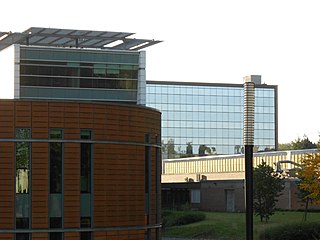Related Research Articles

Located in the campus of Science and Technology of the University of Lille in Villeneuve-d'Ascq ; École Centrale de Lille is a renowned graduate engineering school, with roots back to 1854 as the École des arts industriels et des mines de Lille, re-organised in 1872 as Institut industriel du Nord. It is one of the Centrale Graduate Schools.

The French National Centre for Scientific Research is the French state research organisation and is the largest fundamental science agency in Europe.

The National Institute for Research in Computer Science and Automation (Inria) is a French national research institution focusing on computer science and applied mathematics. It was created under the name Institut de recherche en informatique et en automatique (IRIA) in 1967 at Rocquencourt near Paris, part of Plan Calcul. Its first site was the historical premises of SHAPE, which is still used as Inria's main headquarters. In 1980 IRIA became INRIA. Since 2011, it has been styled Inria.

The Lille 1 University of Science and Technology was a French university located on a dedicated main campus in Villeneuve d'Ascq, near Lille, with 20,000 full-time students plus 14,500 students in continuing education (2004). 1,310 permanent faculty members plus 1,200 staff and around 140 CNRS researchers work there in the different University Lille 1 institutes and 43 research labs. University Lille 1 was a member of the European Doctoral College Lille Nord de France, which produces 400 doctorate dissertations every year. The university is ranked in the world top 200 universities in mathematics by the Shanghai ranking.
The Parallel Multithreaded Machine (PM2) is a software for parallel networking of computers.
LIFL may refer to:

The École Centrale de Marseille is a leading graduate school of engineering located in Marseille, the second largest city in France. The École Centrale de Marseille was created in 2006 by the merging of different previous institutions and has its origins from the École d'ingénieurs de Marseille founded in 1890. It is one of the Centrale Graduate Schools and a member of the TIME network.

The University of Bordeaux 1 was a French university, in the Academy of Bordeaux. Its main campus was in Talence. It had many important laboratories such as :
The Laboratoire d'Informatique de Grenoble is the largest research laboratory of Informatics in Grenoble, France. It was created 1 January 2007, as the result of a union of the 24 research teams of the previous IMAG Institute and the INRIA Rhône-Alpes.

The TELECOM Nancy is a grande école of engineering created in 1990. It is associated with the University of Lorraine. TELECOM Nancy is a school associated to the Institut Mines-Télécom. It is the only school of generalised engineering studies in IT and digital sciences and technologies accredited by the Commission des Titres de l’Ingénieur in the Greater East of France.
The Laboratoire d'Automatique, Génie Informatique et Signal (LAGIS) is a French research laboratory located on the Science campus of the University of Lille. It is hosted in the premises of École centrale de Lille. Since January 2015, the LAGIS has merged with another laboratory, the Laboratoire d'Informatique Fondamentale de Lille (LIFL). The resulting laboratory is now CRIStAL.
Unité de catalyse et de chimie du solide de Lille is a French research laboratory focused on process engineering and chemical engineering.
Brian A. Barsky is a Professor at the University of California, Berkeley, working in computer graphics and geometric modeling as well as in optometry and vision science. He is a Professor of Computer Science and Vision Science and an Affiliate Professor of Optometry. He is also a member of the Joint Graduate Group in Bioengineering, an inter-campus program, between UC Berkeley and UC San Francisco.

The École nationale supérieure de chimie de Lille was founded in 1894 as the Institut de chimie de Lille. It is part of the Community of Universities and Institutions (COMUE) Lille Nord de France.

The École nationale supérieure d'ingénieurs de Poitiers is a French generalist engineering grande école in Poitiers, the regional capital of former Poitou-Charentes now part of Nouvelle-Aquitaine. Its focus is on the protection of the environment and is part of the University of Poitiers, one of the oldest universities in Europe.

The University of Lorraine, often abbreviated in UL, is a grand établissement created on 1 January, 2012 by the merger of Henri Poincaré University, Nancy 2 University, Paul Verlaine University – Metz and the National Polytechnic Institute of Lorraine (INPL). It aimed to unify the main colleges of the Lorraine region. The merger process started in 2009 with the creation of a "pôles de recherche et d'enseignement supérieur" or PRES.

The University of Lille is a French pluridisciplinary public university located in and around Lille, Hauts-de-France. It has its origins in the University of Douai (1559), and resulted from the merger in 2018 of the three universities Lille 1 University of Science and Technology, Lille 2 University of Health and Law, and Charles de Gaulle University – Lille III. With more than 74,000 students, it is one of the largest French university and one of the largest French-speaking universities in the world.

Marie-Paule Cani is a French computer scientist conducting advanced research in the fields of shape modeling and computer animation. She has contributed to over 200 research publications having around 5000 citations.

Martine-Michèle Sebag is a French computer scientist, primarily focused on machine learning. She has over 6,000 citations.
Véronique Cortier is a French mathematician and computer scientist specializing in cryptography. Her research has applied mathematical logic in the formal verification of cryptographic protocols, and has included the development of secure electronic voting systems. She has also contributed to the public dissemination of knowledge about cryptography through a sequence of posts on the binaire blog of Le Monde. She is a director of research with CNRS, associated with the Laboratoire Lorrain de Recherche en Informatique et ses Applications (LORIA) at the University of Lorraine in Nancy.
References
Coordinates: 50°36′35″N3°08′14″E / 50.60972°N 3.13722°E